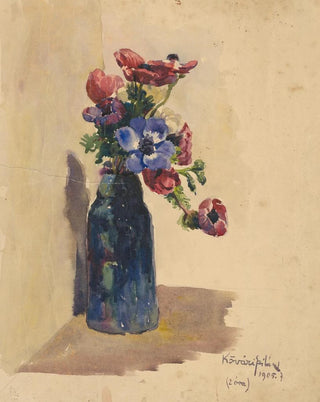Art print | Bouquet of Flowers by Konstantin Korovin


View from behind

Frame (optional)
Art print Bouquet de fleurs de ponch - Konstantin Korovin – Engaging introduction
In the vibrant universe of art, some works manage to capture the very essence of beauty and nature. "Bouquet de fleurs de ponch - Konstantin Korovin" is one of those creations that transcends the simple act of painting to become a true ode to life. This painting, rich in colors and emotions, invites the viewer to immerse themselves in a lush garden where each flower seems to tell a story. Through this piece, Korovin transports us to a world where the lightness of petals and the depth of hues intertwine to create an atmosphere that is both soothing and enchanting.
Style and uniqueness of the work
Konstantin Korovin's style is characterized by an impressionist approach distinguished by its bold use of color and light. In "Bouquet de fleurs de ponch," vibrant shades and fluid brushstrokes give each flower a life of its own. The bright tones of red, yellow, and violet blend harmoniously, creating a painting with striking chromatic richness. The artist masters the art of composition, arranging the flowers to guide the viewer's gaze across the piece. This technique, combined with his sensitivity to floral motifs, allows Korovin to transcend realism and offer an almost poetic vision of nature. The lightness of forms and the transparency of colors evoke a frozen moment in time, where the ephemeral beauty of flowers is celebrated with extraordinary delicacy.
The artist and his influence
Konstantin Korovin, an emblematic figure of the Russian impressionist movement, left his mark on his era with his innovative approach to painting. Born in 1861, he was influenced by the great European masters while developing a style that was uniquely his own. His passion for light and color is reflected in his works, which capture the essence of daily life and Russian landscapes. Korovin also played a key role in introducing Impressionism to Russia, inspiring many artists to explore new techniques and move away from academic conventions. His legacy endures today, and "

Matte finish

View from behind

Frame (optional)
Art print Bouquet de fleurs de ponch - Konstantin Korovin – Engaging introduction
In the vibrant universe of art, some works manage to capture the very essence of beauty and nature. "Bouquet de fleurs de ponch - Konstantin Korovin" is one of those creations that transcends the simple act of painting to become a true ode to life. This painting, rich in colors and emotions, invites the viewer to immerse themselves in a lush garden where each flower seems to tell a story. Through this piece, Korovin transports us to a world where the lightness of petals and the depth of hues intertwine to create an atmosphere that is both soothing and enchanting.
Style and uniqueness of the work
Konstantin Korovin's style is characterized by an impressionist approach distinguished by its bold use of color and light. In "Bouquet de fleurs de ponch," vibrant shades and fluid brushstrokes give each flower a life of its own. The bright tones of red, yellow, and violet blend harmoniously, creating a painting with striking chromatic richness. The artist masters the art of composition, arranging the flowers to guide the viewer's gaze across the piece. This technique, combined with his sensitivity to floral motifs, allows Korovin to transcend realism and offer an almost poetic vision of nature. The lightness of forms and the transparency of colors evoke a frozen moment in time, where the ephemeral beauty of flowers is celebrated with extraordinary delicacy.
The artist and his influence
Konstantin Korovin, an emblematic figure of the Russian impressionist movement, left his mark on his era with his innovative approach to painting. Born in 1861, he was influenced by the great European masters while developing a style that was uniquely his own. His passion for light and color is reflected in his works, which capture the essence of daily life and Russian landscapes. Korovin also played a key role in introducing Impressionism to Russia, inspiring many artists to explore new techniques and move away from academic conventions. His legacy endures today, and "






